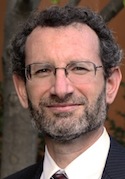
Before Barack Obama was elected president, San Francisco embraced health reform. In 2006, the city rolled out the Healthy San Francisco program with the goal of providing healthcare access to the city’s uninsured population. The program was funded by the city, the federal government, patient co-payments, and fees paid by San Francisco businesses. And once Obamacare plans were set up in California, one of the earliest states to embrace the controversial health legislation, the city’s health centers and health leaders encouraged people to sign up. This hasn’t been the case in many other American states and cities that are still resisting Obamacare.
In advance of the Zócalo/The California Wellness Foundation Event, “What Can Obamacare Learn from San Francisco?”, we asked health policy experts: Based on your experience with health reform in San Francisco, how would you improve Obamacare’s implementation?

House Speaker John Boehner is suing President Barack Obama over postponing the implementation of employer requirements in the Affordable Care Act. At the same time, some members of Congress are working to weaken or overturn the provision. As Congress decides what to do, they should look to San Francisco.
Under the Affordable Care Act (ACA), larger firms that do not offer affordable health coverage to employees working 30 hours a week or more must pay a penalty if any employees receive subsidized coverage through the new marketplaces. The provisions are designed to reduce the incentive for employers to drop coverage in response to the newly available healthcare subsidies and to help pay for the cost of the subsidies. The Congressional Budget Office estimates that without the requirement a million fewer people would receive coverage on the job—and costs to the federal government would go up by $140 billion over the next 10 years. Critics argue that the requirement creates an incentive for employers to reduce workers’ hours to avoid the penalty and that it will cost jobs. San Francisco provides important lessons on both fronts.
Under the San Francisco Health Care Security Ordinance, employers with 20 or more workers must spend a minimum amount per worker per hour on health care. The rule applies to any employee working eight or more hours a week. Researchers found that the law works: More employers offered coverage, the quality of that coverage was maintained even as standards eroded in surrounding counties, and there was no measurable impact on employment. Since the employer contributions are determined on an hourly basis, there is no incentive to cut workers’ hours. Rather than weakening or getting rid of the employer responsibility requirement in the ACA, Congress should follow San Francisco’s example and pro-rate the penalty by the hour and include part-time workers.
Ken Jacobs is chair of the UC Berkeley Center for Labor Research and Education and co-editor of “When Mandates Work: Raising Living Standards at the Local Level.”

Implementation of the ACA has been smoother in San Francisco and California than in most other places. In San Francisco, we built upon Healthy San Francisco, a local network of healthcare providers serving uninsured persons that was established in 2007. It paved the way for ACA implementation by giving providers an opportunity to develop a model of care that emphasized prevention and management of chronic disease.
However, ACA implementation hasn’t been perfect. The major challenge will be to ensure that persons who are eligible for Covered California (the state’s new health insurance exchange) or Medi-Cal (health insurance for low-income Californians) obtain the right information at the right time and in the right language.
First, the good news: Because of the ACA, the percentage of uninsured Californians has fallen by 50 percent over the past year. The average increase in premiums for Covered California enrollees in 2015 will be small.
However, the backlog of Medi-Cal applications must be cleared so people won’t spend months wondering whether their applications were approved. Covered California and health plans need sufficient staff to answer questions in a timely manner. Computer systems have to be ready to handle the inevitable surges as deadlines approach.
Consumers should also have accurate information about provider networks so they can make informed choices. Two San Franciscans have filed a lawsuit against one Covered California health plan alleging that the plan did not inform them that only a limited number of physicians in its network are participating in the plan they purchased. Covered California and Medi-Cal must ensure forms are available in multiple languages on the first day of open enrollment and that persons advising immigrants have accurate information about eligibility. This is critical in San Francisco because 37 percent of adult San Franciscans speak a language other than English, and 48 percent of them do not speak English very well.
We’ve done a pretty good job of implementing the ACA but we can do better, especially at the state level, where most of the power to improve implementation of the ACA lies.
Janet M. Coffman is associate professor at the Philip R. Lee Institute for Health Policy Studies and the Department of Family and Community Medicine at the University of California, San Francisco

In states like California that embraced Medicaid expansion as part of the ACA, the act is fulfilling its promise to reduce significantly the numbers of the uninsured.
The ACA was based on the idea of the “triple aim”: improving patient experience and quality of care, improving the health of the overall population, and reducing healthcare costs. Under the ACA there are some pilot programs to improve patient care and reduce costs. However, despite the ACA’s triple aim, public and private healthcare payers continue to resist investment in primary care.
Our experiences in San Francisco’s clinics show that a patient’s ability to follow a treatment plan improves with enough time with a primary care provider who is sensitive to language barriers, the demands of low-wage jobs, and stressful living conditions, and who also works to integrate mental health and support services into medical care. Take the case of Sam, a 62-year-old dishwasher who was having trouble controlling his Type 2 diabetes when he visited one of the clinics we work with. Clinic staff worked with him to figure out the best meals for him from the menu of the restaurant he works at and to make a plan for eating at home where he didn’t have access to a stove. They also developed a unique insulin regimen tailored to his long hours at work. In a return visit, Sam’s blood-sugar level dropped significantly.
But given the way that healthcare payers reward “productivity” (that is, more patients seen a day), spending time with patients is discouraged, even if getting Sam’s diabetes under control could reduce the chance a costly interventions later, such as emergency room visits, amputations or vision problems.
And, the extra funding provided as part of the ACA for community health centers like our clinics expires at the end of 2015, putting community clinics face-to-face with a dramatic “fiscal cliff” and the threat of losing capacity to care for their patients. Those in San Francisco could face a cut to their federal grant of up to 70 percent.
Deena Lahn is the vice president of policy and advocacy for the San Francisco Community Clinic Consortium (SFCCC). The SFCCC’s partner community-based health centers provide primary care to over 10 percent of San Francisco’s population. The consortium website is www.sfccc.org.



